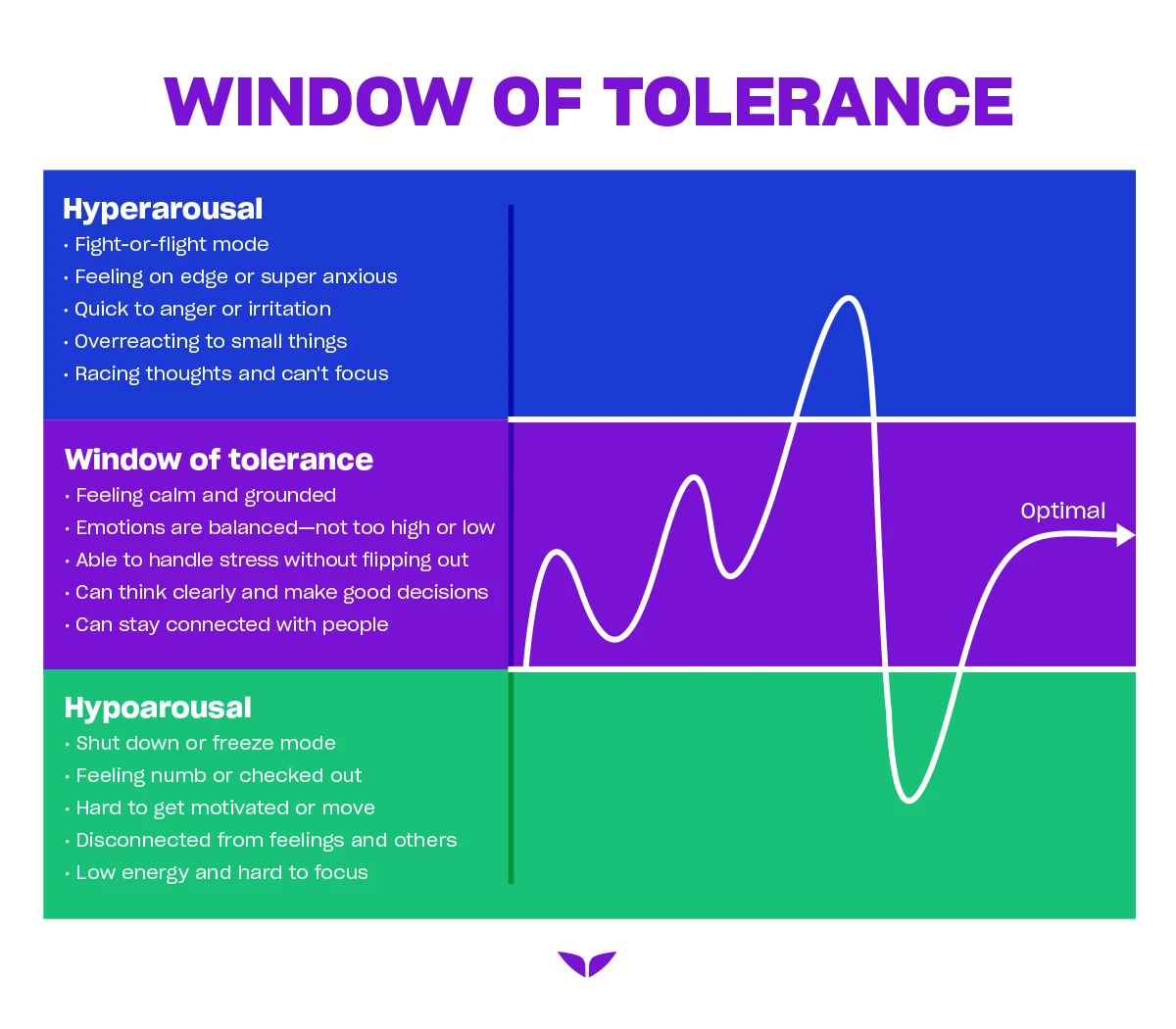Ever notice how some days you can handle chaos like a pro, but other days? Man, the teeniest, tiniest thing can just set you off?
That swing—and how you handle it—is all about your window of tolerance. It’s the range where stress feels manageable and you’re able to stay calm, cool, and collected.
“When you don’t notice [your feelings], they regroup and get stronger and stronger until they erupt,” says Marisa Peer, the creator of Rapid Transformational Therapy®, in her Rapid Transformational Hypnotherapy for Abundance Quest on Mindvalley.
But when you learn to expand that window, resilience becomes second nature. And the stressors that used to throw you off? They start to feel a whole lot smaller.
What is the window of tolerance?
The window of tolerance, a concept developed by professor of psychiatry Dr. Dan Siegel, is basically your comfort zone for managing stress and emotions. It’s the range where you feel you can handle life’s ups and downs without feeling overwhelmed or shutting down.
Perhaps you’ve heard of it? It’s essentially being “regulated” by any other name.
According to Ny’L Thompson, LCSW-C, M.S., a therapist with ADHDAdvisor.org, when we’re inside this window, “we can think clearly and manage stress well.” But it’s when we go outside of it that we feel like everything’s haywire.
Everyone’s window of tolerance is unique, shaped by things like one’s background, personal experiences, and even childhood. For those who have gone through trauma, this window can be smaller, as trauma causes shifts in brain chemistry that make it harder to stay calm when stress hits.
A window of tolerance diagram is a great way to see this in action. It shows how we stay steady inside the window but tip into hyperarousal or hypoarousal when we’re pushed outside it.
Hyperarousal vs. hypoarousal
When someone is pushed outside their window of tolerance, they go into either hyperarousal or hypoarousal. Here’s a quick breakdown of both:
Hyperarousal is when the nervous system is on high alert. Ny’L explains it as “when we’re overstimulated, feeling anxious, jumpy, or irritable.”
You might experience a racing heartbeat, sweaty palms, trouble concentrating, insomnia, or a sense of constant agitation. Being in this state can also make it hard to relax, think clearly, or respond calmly.
It’s similar to what someone who’s been in a car accident might feel. Every time they hear tires screeching, their heart races, they get sweaty palms… Even though they’re safe, their body responds as if they’re still in danger.
Hypoarousal, on the other hand, is like hitting the body’s “off” switch. People who’ve gone through a breakup or lost a loved one, for instance, might know this state very well.
Instead of crying or expressing what they feel, people in hypoarousal might go numb, feel totally drained, or go into that thousand-yard stare. They might pull away from friends, find it hard to enjoy things, or even struggle to do simple daily tasks.
“It might look like low energy, zoning out, or feeling ‘shut down,’” says Ny’L. But it’s the body’s way of conserving energy when everything feels just too much to handle.

How trauma can affect the window of tolerance
If you’ve been through a traumatic experience, your nervous system can get stuck in survival mode. This can make it harder to stay within the zone of arousal where your emotions feel manageable.
According to Ny’L, complex trauma, like abuse, neglect, sudden loss, or being caught in a trauma bond, can have “a stronger impact than a single traumatic event because it shapes how the brain responds to stress.” However, she adds that those single events can also affect emotional tolerance, especially if they’re severe.
This lingering effect of trauma means that people may find themselves overreacting to everyday stressors or, on the other hand, feeling disconnected and numb. Research even shows that over 70% of adults experience at least one traumatic event in their lifetime, which suggests just how common it is for people to experience shifts in their capacity to handle stress.
When you understand the connection between trauma and the window of tolerance, it gets easier to build effective coping strategies for emotional regulation.
5 common signs of a disturbed window of tolerance
When the window of tolerance is narrow, life’s challenges can start feeling a bit too intense. Here are some telltale signs that you might be operating outside your comfort zone:
- Your body is on high alert, almost like it’s waiting for something bad to happen.
- You have trouble concentrating, like rereading the same line or zoning out in the middle of a conversation.
- You feel detached, like your emotions are on mute. That can make it hard to connect with what’s going on around you.
- You might feel drained, as if even small tasks take all your energy.
- You feel easily annoyed or experience quick shifts in mood. This happens because the body’s natural coping systems are maxed out, making small frustrations feel huge.
- You might start dodging people or places that once felt fine.
- You have difficulty sleeping, either tossing and turning at night or having trouble staying awake during the day.
Sure, these signs can feel like they’re boxing you in, but the good news? This window isn’t set in stone.
Ny’L says that it’s possible to expand it with support, self-care, and practice. The goal is to build tools that can help you control your emotions, which will allow you to feel more at ease over time.
How to increase the window of tolerance: 5 expert-backed techniques
Knowing how to expand the window of tolerance doesn’t happen overnight. However, with a few simple yet effective techniques, you can improve self-regulation to stay more grounded whenever life gets chaotic.
1. Identify limiting beliefs
“Better safe than sorry.”
“No pain, no gain.”
“People don’t change.”
“You can’t have it all.”
“Success requires sacrifice.”
What do all of these have in common? They’re typical catchphrases that pose as limiting beliefs.
Unfortunately, many of us carry them, and they can make us feel stuck. They create stress and happily push us out of that zone of arousal.
Marisa’s advice is to start by calling them out. “When you question a belief, guess what? You don’t believe it anymore,” she poses.
For instance, if you catch yourself thinking, “Success requires sacrifice,” ask yourself: Is that really true? Are there examples of people who found success without burning themselves out?
Marisa also suggests flipping these beliefs into something more empowering. Like, change “better safe than sorry” to “taking risks can lead to new opportunities.” Or instead of “people don’t change,” think, “people grow and evolve all the time.”
When you’re able to let go of the beliefs that trigger stress, it makes it easier to face new situations with a clear, calm mindset. Next time you catch yourself holding onto a limiting belief, try this exercise and notice how your reactions start to shift over time.
And remember Marisa’s words: “The only limitation is your mind.”
2. Practice positive self-talk
How you talk to yourself can help you stay steady when life gets messy. Marisa’s advice? Flip the script whenever those inner voices start to drag you down.
“The most important words you say in your life are the words you say to yourself,” she says. As a matter of fact, research shows that self-talk can shape motivation, mood, and even help handle stress more easily.
Marisa suggests having a few “power phrases” on standby. Her go-to is “I am enough” (feel free to make it yours too), but it could be anything that grounds you, like “I am strong,” “I am calm,” or “I can handle whatever comes my way.”
They’re indeed simple, but when you say them on repeat, these powerful reminders can help rewire your brain to see yourself as capable and resilient. And the more you practice, the more these thoughts become second nature.
3. Focus on daily self-care rituals
Self-soothing activities play a big role in keeping us balanced. Sure, it often gets tied to things like bubble baths and cozy blankets, but the real foundation is actually the basics: food, hydration, sleep, and movement.
“It sounds so simple, but it’s very easy to forget to care for yourself,” Marisa points out. She adds that we often expect our bodies to do so much for us. However, when we do something back for it, it will “reward [us] and do so many better things for [us].”
Ny’L also recommends some practical window of tolerance exercises that can help:
- Grounding exercises. One popular one is the 5-4-3-2-1 exercise: Notice five things you can see, four things you can touch, three things you can hear, two things you can smell, and one thing you can taste.
- Progressive muscle relaxation. Start by tensing the muscles in your feet for 5-10 seconds, then release. Move up through your body—legs, stomach, arms, shoulders, neck—tensing and releasing each group.
- Time in nature. Step outside and soak in some fresh air, whether it’s a walk in the park, a hike, or simply sitting under a tree.
- Expressive arts. Think doodling, journaling, or painting. Let your thoughts and emotions flow onto the page.
- Small lifestyle changes. Work on getting enough sleep, reducing caffeine, or adding a quick walk into your day.
When your body’s run down, stress can knock you out of your comfort zone much faster. But keeping these basics in check? That sets you up to roll with whatever life throws your way.
4. Take breaks when things get too intense
Give yourself permission to pause instead of pushing through nonstop. Ny’L suggests that a quick change in scenery or a few minutes to yourself can help reset your mind, especially if you’re feeling overwhelmed.
In fact, research shows that “micro-breaks” boost energy and reduce fatigue—especially if the task at hand is mentally exhausting. Even something simple, like stretching, walking, or even just taking a few deep breaths, can help your nervous system cool down. From here, it’s more manageable to come back to the task at hand with a fresh perspective.
Not only that, but breaks aren’t just for when you’re on the brink; they’re great for preventing things from getting too intense in the first place. So next time things get a little too much, step back, breathe, and give yourself a moment to reset.
5. Seek support
It’s a cliché to say, “You’re not alone.” The fact of the matter is, you really aren’t. And when you’re struggling with hyperarousal or hypoarousal, reaching out for support, as Ny’L points out, “can make a big difference.”
Talk things out with friends, family, or a therapist. Or spend time around people who make you feel safe and comfortable.
The choice is yours. But don’t hesitate to lean on those around you—they’re there to help, and it can be a real boost to your resilience.

Futureproof your well-being
Some days, life throws its best punches. But wouldn’t it be something to meet them with calmness and confidence, no matter what?
Marisa’s 5 Steps to Reprogram Your Mind for Abundance Masterclass on Mindvalley is your toolkit for exactly that. In this free session, she takes you through her powerful Rapid Transformational Therapy™—the same powerful approach she’s used with Olympians, CEOs, and thousands of others to rewire their minds for abundance in health, wealth, and love.
Just ask Mabel Wong, the owner of Dermaly Skin Wellness, who felt “very stressed out,” discouraged, and even isolated before Marisa’s program. Now, she says she’s “much more relaxed and happy,” free of the guilt, self-sabotage, and scarcity mindset that once held her back.
Now, it’s your turn. Build your resilience. Expand your window. And you might just find yourself meeting life’s storms with a new level of clarity, steadiness, and strength.
Welcome in.










